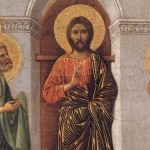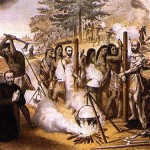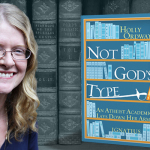No Naysayers at NASA: Responding to Bob Seidensticker
by Fr. Dwight Longenecker
Filed under Historicity
EDITOR'S NOTE: This post from Fr. Dwight Longenecker is in response to atheist Bob Seidensticker's post yesterday titled 10 Reasons to Just Say Nay to the Naysayer Hypothesis.
Atheist Bob Seidensticker has a quip at the bottom of yesterday's blog post which reads, “If a million people say a foolish thing it is still a foolish thing.” I couldn’t agree more, and we should remember this as we read the rest of his post. His basic argument is this:
“Apologists tell us that the gospels were written at a time when many disciples—the eyewitnesses—were still alive. If they heard an inaccurate story, they’d say, “I was there, and that’s not the way it happened!” They’d shut it down. An incorrect version of the story would not have survived.”
Bob then goes on to give ten reasons why there were no such naysayers. I’m not going to respond to the reasons one by one. Instead I’ll deal with the basic false assumptions, rooted in some very elementary ignorance of the facts of New Testament scholarship, historical scholarship, and what actually happened. Of course, if false, these assumptions make his conclusions irrelevant.
In his second point, Bob asserts this:
“We imagine a handful of naysayers who know that the Jesus story is only a legend, but that was in the year 30. Now the first gospel is written and it’s roughly forty years later—how many are still alive? Conditions were harsh at that time, and people died young. Many from our little band of naysayers have died or been imprisoned by this point.”
It sounds kind of plausible, but this isn’t how it happened. The gospels didn’t suddenly appear in written form after 70 AD in order to be dissected by naysayers. The gospels emerged from the preaching of the apostles which had been going on since the day of Pentecost fifty days after the resurrection of Jesus Christ.
The gospels aren’t some kind of four part historical biography of Jesus written by some smart guy forty years after the event. They are unique documents which emerged from the experience of the apostles and the early Church. Therefore we don’t ask if there were any naysayers around to disprove the gospels from 70 AD onward. We ask whether there were any naysayers around when the gospel was hot and fresh when the apostles were preaching—first in Jerusalem and then around the Empire.
Furthermore, Bob doesn’t understand the true dating of the gospels. He repeats the tired old idea that they must date from after 70 AD. The only reason for this dating is the modernist scholar's assumption that Jesus could not have prophesied the destruction of the Jerusalem temple, which happened in 70 AD. Why? Simply because prophecies of the future are impossible. Why? Because they say so.
In fact, we have another historically verified date which enables us to date the gospels. It is the deaths of Peter and Paul in 65 AD under the persecution of Nero. Their deaths are not recorded in the Acts of the Apostles, which is surprising since the Acts of the Apostles is all about their ministry. Their martyr’s deaths would surely have been recorded if they had taken place.
The Acts of the Apostles is acknowledged by most scholars as a reliable historical record. Furthermore, it is the second volume by the same author—the first volume being the gospel according to Luke. If the Acts of the Apostles dates from before 65 AD, then the Gospel of Luke must be earlier than that. In addition, most scholars argue that Luke was influenced by Mark’s gospel. This means that the earliest gospels were probably written between 50 AD and 65 AD (some scholars place them even earlier.)
All of Bob’s other arguments about the reasons why there were no naysayers after 70 AD are irrelevant for two reasons: firstly the gospels did not just arrive in the bookstores in 70 AD. Secondly, and most importantly, Bob misunderstands the whole naysayer argument. He spends a long time telling us why there were no naysayers, but that’s not the question in the first place.
To pick up on his first point:
"Apologists tell us that the gospels were written at a time when many disciples—the eyewitnesses—were still alive."
No we don't. We say the gospel stories were told in the apostolic preaching at a time when many eyewitnesses were still alive. Furthermore, we’re saying that there were naysayers, but that their arguments didn’t hold up. Let’s look at the facts: when the gospel was hot and fresh in Jerusalem in the days after the Resurrection there were plenty of people there who knew Jesus, knew what had happened, and were ready to dispute with the disciples. In fact, in the Gospels we discover naysayers. The Jewish leaders said the disciples stole Jesus’ body (Matthew 28:11-15). Other naysayers heartily denied that Jesus was the Son of God. They said Jesus' miracles were produced by the devil. (Notice, though, that they didn't dispute that he did miracles...) In fact the naysayers were so vehement in their naysaying that they persecuted the Christians. Saul—later St. Paul—was one of their number. There were indeed plenty of naysayers in Jerusalem at the time when many witnesses to the events were present.
Our point is not that there were no naysayers but that there were plenty and that they still couldn’t disprove what the apostles were saying. In those early days in Jerusalem, then in Antioch, then in the communities dispersed first by the Jewish persecution, and then by the destruction of Jerusalem in 70 AD, there were plenty of Jews who knew what had happened.
However many didn’t believe the Pharisees’ take on it. They believed the apostles. That’s why the Christian church grew as it did—because the apostolic witness to the life, death, and resurrection of Jesus Christ was convincing and life changing.
In the end, an argument trying to explain why there were no naysayers to the gospel is like a conspiracy theorist trying to explain why there are no lunar landing deniers working at NASA. You may come up with ten astounding reasons why there are no lunar landing deniers at NASA, but it might just be because there was a lunar landing and the people at NASA—along with most other people—accept the simple facts of what really happened.
Related Posts
Note: Our goal is to cultivate serious and respectful dialogue. While it's OK to disagree—even encouraged!—any snarky, offensive, or off-topic comments will be deleted. Before commenting please read the Commenting Rules and Tips. If you're having trouble commenting, read the Commenting Instructions.













